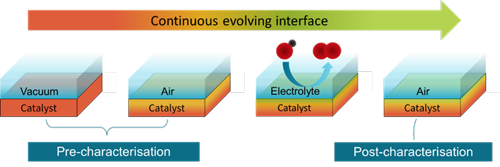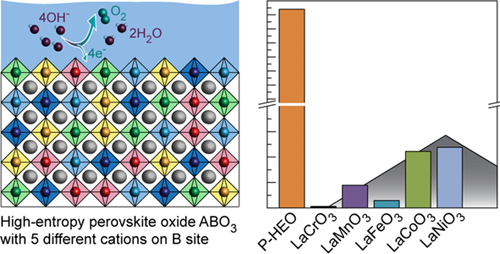Master project
Project motivation
The hydrogen economy is a promising pathway to reach sustainability goals. During electrochemical water splitting, a water molecule is split into hydrogen and oxygen. Here, hydrogen can be used as a carbon-neutral energy carrier. However, in electrochemical water splitting, catalysts for the oxygen evolution reaction are required to improve the sluggish kinetics. There is a search for efficient, stable, earth abundant and cheap catalysts. To find good replacement catalysts, a better understanding of the catalytic surface under reaction conditions is required. Currently, there is a lot of pre- and post-characterization done at catalysts. However, this is not sufficient due to the continuously evolving interface of the catalyst (fig 1). To enable characterization under reaction conditions, we need to work on improved sample designs.

Figure 1 Schematic of continuously evolving interface
A promising catalysts for the oxygen evolution reaction are high entropy oxides. This is a material that contains five or more elements and has superior activity compared to the single element compounds (fig 2). Studying this material at operating conditions might unravel the properties giving superior performance.

Figure 2 Schematic of high entropy perovskite oxide and its superior activity, adopted from ACS Nano 2023, 17, 6, 5329–5339
Therefore, for this project these high entropy oxides have to be deposited on holy substrates which allow for measurements with x-rays through the back of the sample. The advantage of this sample design is that you don’t have to measure through the electrolyte, which is a large x-ray absorber. So how do we get a film of high entropy oxide on such a holy substrate (fig 3)? The idea is to grow these high entropy oxides on a substrate with a sacrificial layer. This sacrificial layer will then be dissolved with water and you have created a free standing film. Subsequently, the free standing film will be deposited on a holy substrate, enabling us to characterize the catalyst through the back of the sample.

Figure 3 Schematic of growth and deposition of a free standing film on a holy substrate, adopted from Nature 570, 39-40 (2019)
Project goal
Optimize the deposition of free standing high entropy films for operando characterization at operating conditions.
Role of the student
We are looking for a motivated master student with a background in Chemistry, Material Science, Physics, or Nanotechnology. The assignment consists, but is not limited to the following key tasks:
- Deposit with pulsed laser deposition (PLD) a sacrificial layer with the HEO on a substrate
- Dissolving the sacrificial layer and depositing the free standing film on holy substrates/membranes
- Evaluate the quality of the deposited free standing films, using AFM, SEM and electrochemical measurements
- There is the possibility to join a one week synchrotron experiment at ESRF to perform the operando x-ray experiments
Contact information
Chris. Baeumer (Supervisor) c.baeumer@utwente.nl
Iris van den Bosch (Daily supervisor) i.c.g.vandenbosch@utwente.nl
